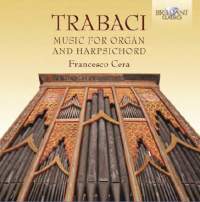Texte paru dans: / Appeared in: |
|
|
Outil de traduction (Très approximatif) |
|
|
|
|
|
Reviewer: Bertil
van Boer I confess to have little knowledge about Giovanni Maria Trabaci (1575–1647), other than the odd oblique reference in the keyboard organ works of the early Baroque period. Born in a small village in southern Italy, nothing is known about his early life or training, other than it may have been local near the city of Potenza or perhaps at one of the conservatories in Naples. By 1594 he was already active in the latter as an organist at the Oratorio di Filippini. Within a few years his fame had earned him the post of organist at the royal cappella, and by 1601 he was beginning to publish his keyboard music in a series of volumes. The following year he published his Motectorum, a selection of motets in the new monodic style. He went on to compose some of the earliest Italian passions, and became the principal composer for the court up to his death in 1647, about the same time as Spanish rule in Naples deteriorated into revolution under the smuggler Masaniello. Trabaci composed a considerable amount of music, almost 300 works, of which the principal focus was on works for the keyboard. Many of these are more generic, but given the fact that much of the music of the period was playable on a variety of instruments, from organ to clavichord, the choice is moot. What comes out, however, is that Trabaci was extremely facile in his work. For example, the “Conto fermo secondo del secondo tono” from the 1603 first book has a particularly gnarly fantasia-like content wherein the main theme keeps tumbling over itself, spiced every so often with some held chords, all above a slow-moving bass line. It is not flashy or based upon the usual scalar patterns one finds in, say, his contemporary Jan Sweelinck, but rather a deliberate set of contrasts in registers and sequences that add various colors to the music. The “Ricercata nono tono con tre fughe” (and I was almost tempted to write “funghi” here instead, since the counterpoint seems to mushroom out from the flowing main theme) begins with a likewise rather gnarly subject which morphs into the next subject until all three are played simultaneously. In the Versetti based upon the incipit of the Magnificat in the 1615 book, the intonation is followed by a burst of full organ glory, all 10 fingers being used in massive chords. This in turn provides a textural contrast with each short phrase of the chant. The verses are varied, with cascading scalar passages in the second, and an extremely tortuous chromatic fugue in the third, and so forth. It is a compendium of various techniques, all expertly composed and contrasting. In the “Toccata Quarta” of the same book, the various harmonies slowly unfold in sustained chords that provide varied colors, and yet a sense of suspension from out of which bits of fioritura emerge. The second disc contains the secular pieces from the same books, which are performed (not unexpectedly) on a 17th-century harpsichord, one of those heavy instruments with a rather virile sound. That is not to say that the counterpoint, such as the imitation in the opening canzona from the 1603 book, is overlooked, yet there is a rhythmic foundation that is less static than in the sacred works. Of particular interest are the six gagliardas, which have a positive bouncy feel, as if the harpsichord was truly accompanying a dance at a Neapolitan nobleman’s home. They are all full voiced, with the dance patterns clearly discernable and not subsumed beneath virtuoso display. Here, too, one can find a brief exploration of counterpoint, such as in the fugal “Gagliarda Settiman.” Keyboardist Francesco Cera is perhaps the perfect performer of these works. Although his organ registrations vary only narrowly, his choices for the sacred compositions allow for the full effect of the 16th-century instrument in the Church of Sant’Antonio in the town of Salandra to be felt. His harpsichord playing is also very nicely phrased, with special attention to the rhythmic foundations of Trabaci’s works. The recorded sound is quite live, and this lends to my ears a rather vibrant quality to these discs, which makes the works practically bounce out of the speakers. (One can even hear the clicks as the organ registrations are changed, making it a rather important experience for the listener.) In short, this is a terrific disc, and one that ought to be in the collection of anyone interested in keyboard music from the early Baroque. | |
|
|
|
|
Cliquez l'un ou l'autre
bouton pour découvrir bien d'autres critiques de CD |
|




